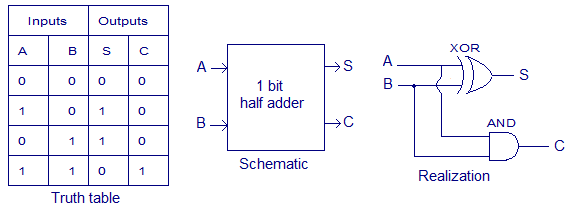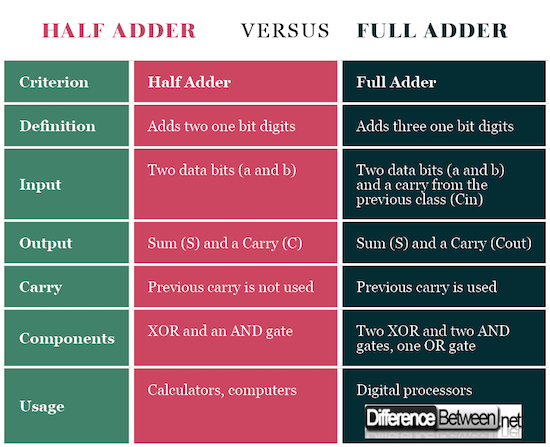Difference Between Half Adder and Full Adder
Full adder and half adder are digital circuit elements used to summarize numbers. In modern computers they are part of the arithmetic logical unit that is responsible for carrying out arithmetic operations. Adders work with electrical signals representing the binary numbers of computers. In electronics, the adder is a digital circuit that is adding numbers. In many computer and other processors, adders are not only used in the arithmetic-logical unit, but also in other parts where it is necessary to calculate the address, index tables and similar operations. Although adders can be constructed for various representations of numbers, such as binary coded decimal numbers, they are usually binary-numbered bitters.
What is Half Adder?
The half adder adds two bits together. The half adder has two input signals representing binary digits (a and b) and two output signals, one of which is the result of the addition (s), and the second the carry in higher class (C). It is important to note that a half adder cannot be used to add multi-digit binary numbers because there is no lower-level carry. The half adder is a combination circuit of XOR and AND circuits. Its purpose, as the name suggests, is to add numbers. The process of adding numbers in the binary system is reduced to the addition of digits, where as a result we obtain a sum and a carry. Since the half adder himself cannot calculate the whole result, it is combined with another half adder and OR circuit to make a full adder.
The truth table used to describe the work of a half adder is:
| a | b | S | C |
| 0 | 0 | 0 | 0 |
| 0 | 1 | 1 | 0 |
| 1 | 0 | 1 | 0 |
| 1 | 1 | 0 | 1 |
where S=a⊕b; C=a*b
What is Adder?
In order to add numbers in a binary system, we need to collect 3 digits by adding a previous carry to the sum of two digits. This is accomplished by using two half-adders and OR circuits. The difference between half adder and adder is that in case of an adder there are three inputs and two outputs, and the adder counts three digits, while the half-adder has two inputs and outputs and counts two binary digits. The full adder has: three input signals, two of which represent the binary digits (a and b), and a third input being the carry from the previous class (Cin); two output signals, one of which is the result of the addition (S), and the second carry in the higher class (Cout). Since a full adder has the previous carry as an input signal, it can be used to add multi-digit binary numbers. The multi-digit binary numbers are added by a cascading connection of multiple full adders. The number of full adders in cascade connection is equal to the number of digits, that is, the bits that have numbers to be added (one adder for each bit).
The truth table used to describe the work of a full adder is:
| a | b | Cin | S | Cou |
| 0 | 0 | 0 | 0 | 0 |
| 0 | 0 | 1 | 1 | 0 |
| 0 | 1 | 0 | 1 | 0 |
| 0 | 1 | 1 | 0 | 1 |
| 1 | 0 | 0 | 1 | 0 |
| 1 | 0 | 1 | 0 | 1 |
| 1 | 1 | 0 | 0 | 1 |
| 1 | 1 | 1 | 1 | 1 |
where S=a⊕b⊕Cin; Cout=(a*b)+(Cin*(a⊕b))
Difference Between Half Adder and Full Adder
-
Definition of Half and Full Adder
Both half adder and full adder are combinational circuits. However, the first one adds two one bit digits, while the second one adds three digits.
-
Input of Half and Full Adder
The half adder has two input values – a and b which represent the data bits. The full adder has additional input – the carry from the lower class (Cin).
-
Output of Half and Full Adder
The half adder has two outputs. One is the sum of the process (S) and the other is the carry of the summation (C). The full adder also has two outputs (S;Cout).
-
Carry
In case of a half adder the carry from the lower class (previous iteration) is not added in the new class. In case of full adder the carry is transferred in the new class, which allows the adder to sum up numbers.
-
Components of Half and Full Adder
The half adder consists of XOR and an AND gate. The full adder is principally two half adders combined together – consists of two XOR and two AND gates and an OR gate.
-
Usage of Half and Full Adder
Half adders are used in computers, calculators, measuring devices etc. Full adders are used in digital processing.
Half Adder vs. Full Adder: Comparison Table
Summary of Half Verses Full Adder
- When two binary numbers are added, firstly the digits are added, i.e. the smallest bits. This operation is performed by a half adder as the simplest network that allows to sum up two one-bit numbers. The input signals in the network are the binary digits of the digits, and the resulting outputs are the sum and the carry.
- When multi-digit numbers are added, the half adder network can be used only to assemble the smallest digits, since the half adder cannot sum up the carry digit from the previous class. The basis of all digital arithmetic devices is the so-called full adder. This network is used to add three single digit numbers. Two numbers are assigned, and the third is the carry from the previous class calculations.
- Difference Between Thermodynamics and Kinetics - June 24, 2018
- Difference Between Welding and Soldering - June 24, 2018
- Difference Between Additive Colors and Subtractive Colors - June 20, 2018
Search DifferenceBetween.net :
1 Comment
Leave a Response
References :
[0]Givone D. D., "Digital Principles and Design", NY: McGraw-Hill, 2002
[1]Leach, D. P., Malvino, A. P. “Experimental in Digital Principles”, 5th Ed., NY: McGraw-Hill, 1994
[2]Bartee, T.C. “Digital Computer Fundamentals“, 6th Ed., NY: McGraw-Hill, 1985
[3]Image credit: http://www.circuitstoday.com/wp-content/uploads/2012/03/half-adder-truth-table-schematic-realization.png
[4]Image Address: https://www.electronicshub.org/wp-content/uploads/2015/06/Parallel.jpg




Useful information. Thank you